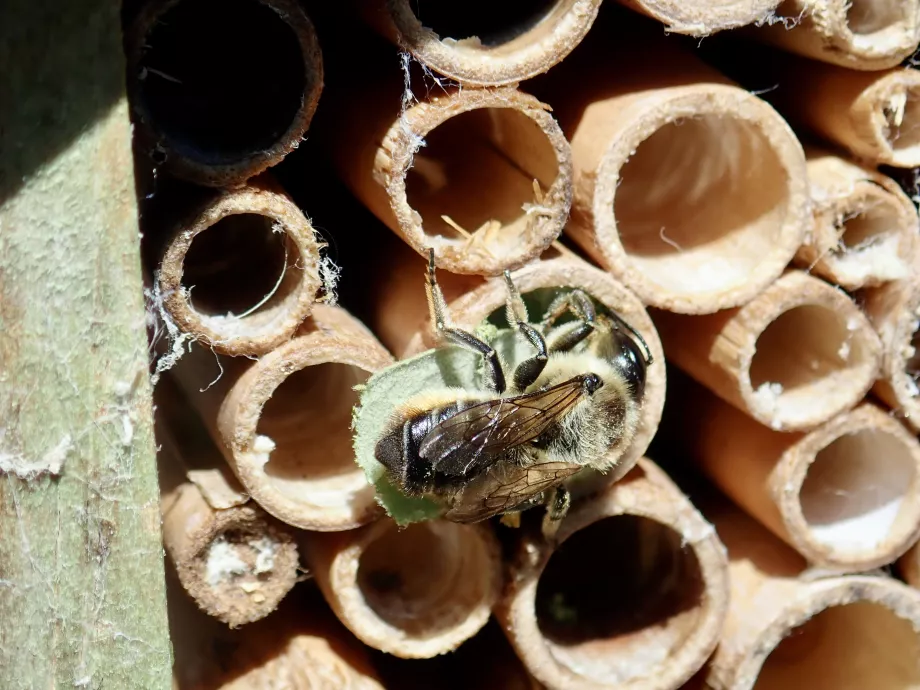
Buff-tailed bumblebee on welsh poppy ©Penny Brook
Food for wildlife and a feast for the eyes
It all starts with healthy soil and compost-making. Micro-organisms and invertebrates in soil rich in organic matter provide a firm foundation for the food chain in the garden. Plants bloom every month of the year in Penny and Peter’s garden ensuring that any insects active from late autumn through to early spring can find pollen and nectar. Penny particularly loves the beautiful hellebores that bring the shady areas of their garden to life as early as January. They are popular with winter-active bumblebee queens. As the hellebores start to fade, the cowslips in the mini-meadow come into bloom. Hairy footed flower bees are often seen foraging in the cowslips. The garden is full of flowering plants in borders and more informal areas to provide as much pollen and nectar as possible for day-flying insects and also for moths. A variety of flower-shapes caters for all tastes. The mini-meadow is usually buzzing and also a good spot for hedgehogs to forage.
Native shrubs in the garden, such as pussy willow and hawthorn, provide food for insect larvae as well as pollen and nectar.
Berries, fruit and nuts feed birds, small mammals and larger animals that visit the garden.

Hairy footed flower bee on a cowslip ©Penny Brook
Shelter for wildlife
Penny and Peter try to provide shelter for wildlife at different stages in the life-cycle – reproduction, active adult phase and over-wintering. Bee homes and a hedgehog home provide shelter in the upper area of borders. The more informal lower part of the garden and the riverbank provide shelter in the form of hedges with brush piles under them, leaf litter in autumn, log piles, stems left through the winter, long grass and a compost heap and hibernaculum.

Patchwork leaf cutter bee ©Penny Brook
Water
A more formal pond near the house is connected by a series of mini-ponds to the main wildlife pond in the more informal area at the bottom of the garden. In spring, marsh marigolds in the damp areas boost pollen and nectar supplies. Later in the year, purple loosestrife is a real magnet for insects. Visit the garden to find out how the ponds each support a different variety of wildlife including grass snakes.

Banded damselfly on frogbit ©Penny Brook
A safe environment for wildlife
One of the best ways to provide a safe environment for wildlife in your garden is to know what is visiting it. Penny and Peter have found it fascinating to learn about the life-cycles of the wildlife visiting their garden. They try to use that knowledge to avoid disturbing wildlife when it is overwintering or its larvae are feeding on plants.
Peter cuts the mini-meadow with a scythe as this is kinder to the wildlife. Interestingly, he has found this classic tool easier and more enjoyable to use than a strimmer.
They avoid using pesticides as they believe it’s safer for them and for the wildlife living in their garden. A healthy garden ecosystem allows beneficial predators to thrive. Over the years, they have learnt which plants are happiest in their garden and concentrate on growing these. Healthy plants can usually withstand the impact of so-called pests. Occasional losses are tolerated on the basis that a garden full of wildlife has far more value and enjoyment for them than an individual plant. Most plants survive - their abundance prompted a friend to admire the ‘mad profusion of flowers that somehow works’!

Ladybird and aphid prey ©Penny Brook
Be inspired by visiting an open garden
The WAG volunteers opening their gardens to the public aim to provide a relaxing afternoon out. Many will be offering refreshments in return for a donation so that you can linger and enjoy the surroundings. They hope you will be inspired to start gardening with wildlife in mind or add to what you are doing already. Whether you have room for just one pot of pollinator-friendly flowers or want to develop a wildlife pond or mini-meadow, the expert volunteers at each open garden will be happy to answer your questions. If you can do just one thing to support wildlife in your outdoor space, you will still make a difference to its survival.
To visit our Open Gardens, please join us at one of our many events below.

